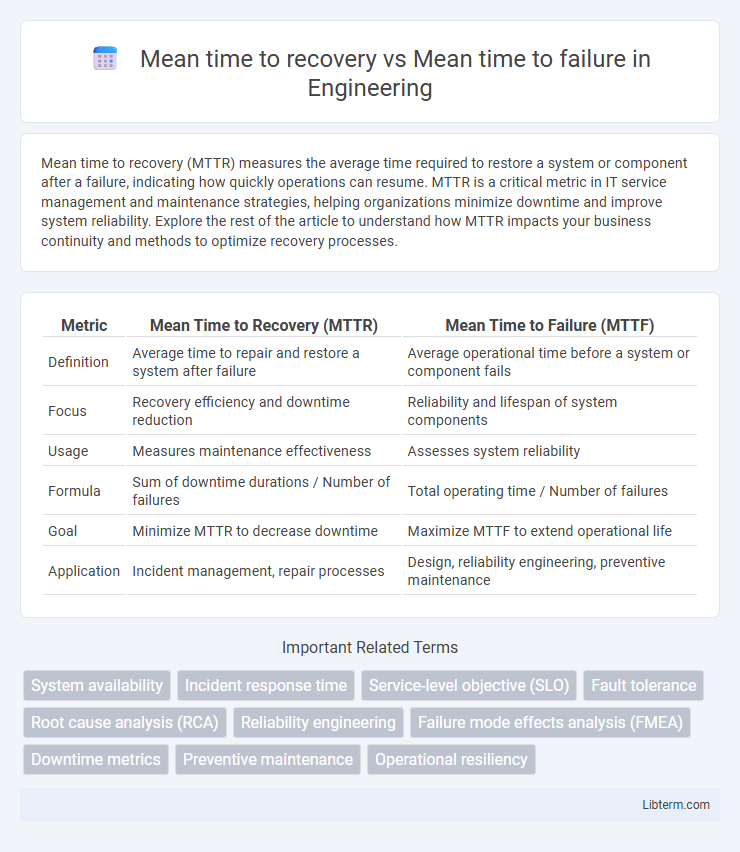Mean time to recovery (MTTR) measures the average time required to restore a system or component after a failure, indicating how quickly operations can resume. MTTR is a critical metric in IT service management and maintenance strategies, helping organizations minimize downtime and improve system reliability. Explore the rest of the article to understand how MTTR impacts your business continuity and methods to optimize recovery processes.
Table of Comparison
| Metric | Mean Time to Recovery (MTTR) | Mean Time to Failure (MTTF) |
|---|---|---|
| Definition | Average time to repair and restore a system after failure | Average operational time before a system or component fails |
| Focus | Recovery efficiency and downtime reduction | Reliability and lifespan of system components |
| Usage | Measures maintenance effectiveness | Assesses system reliability |
| Formula | Sum of downtime durations / Number of failures | Total operating time / Number of failures |
| Goal | Minimize MTTR to decrease downtime | Maximize MTTF to extend operational life |
| Application | Incident management, repair processes | Design, reliability engineering, preventive maintenance |
Understanding Mean Time to Recovery (MTTR)
Mean Time to Recovery (MTTR) measures the average time required to restore a system or component after a failure, reflecting the efficiency of repair processes and maintenance strategies. It is a critical metric for evaluating system reliability and operational resilience, directly impacting downtime and service continuity. Unlike Mean Time to Failure (MTTF), which quantifies average operational lifespan before failure, MTTR focuses specifically on recovery speed to minimize disruption.
Defining Mean Time to Failure (MTTF)
Mean Time to Failure (MTTF) is a key reliability metric that measures the average operational duration of a non-repairable system or component before it fails. It provides insights into product lifespan and helps predict when failures will likely occur, enabling proactive maintenance planning. MTTF contrasts with Mean Time to Recovery (MTTR), which tracks the average time to restore service after a failure, highlighting different aspects of system performance and reliability management.
Key Differences Between MTTR and MTTF
Mean Time to Recovery (MTTR) measures the average time required to restore a system or component after a failure, emphasizing repair speed and operational uptime. Mean Time to Failure (MTTF) indicates the average operational time before a system or component fails for the first time, highlighting reliability and lifespan. MTTR focuses on maintenance efficiency, while MTTF centers on durability and failure prediction.
Why MTTR Matters in Incident Management
Mean Time to Recovery (MTTR) measures the average time required to restore a system after a failure, while Mean Time to Failure (MTTF) quantifies the expected operational lifespan before a failure occurs. MTTR is crucial in incident management because it directly impacts system availability, customer satisfaction, and operational costs by minimizing downtime. Organizations that prioritize MTTR can enhance resilience, improve service level agreements (SLAs), and accelerate the overall recovery process during disruptions.
The Role of MTTF in Predicting System Reliability
Mean Time to Failure (MTTF) is a critical metric used to predict the reliability and expected operational lifespan of non-repairable systems before a failure occurs. Unlike Mean Time to Recovery (MTTR), which measures the average time required to restore a system after failure, MTTF focuses on the duration a system remains fully functional, thus informing maintenance schedules and risk assessments. Accurate MTTF calculations enable engineers to design more resilient systems by identifying vulnerable components with shorter lifespans, ultimately improving overall system reliability.
Calculating MTTR: Methods and Best Practices
Calculating Mean Time to Recovery (MTTR) involves measuring the average time taken to restore a system or component after a failure, focusing on accurate incident logging and timely repair processes. Best practices include detailed downtime tracking, root cause analysis, and standardizing recovery protocols to minimize delays. Leveraging automated monitoring tools and maintaining clear communication channels enhances the precision of MTTR calculations while improving overall system reliability compared to Mean Time to Failure (MTTF) metrics.
Techniques for Measuring MTTF Effectively
Techniques for measuring Mean Time to Failure (MTTF) effectively include accelerated life testing, which simulates extended operational conditions to predict failure rates quickly, and time-to-failure analysis using statistical models such as Weibull distribution to assess reliability accurately. Data collection from real-world usage through telemetry and monitoring systems provides empirical insights, enhancing the precision of MTTF calculations. Properly implemented MTTF measurement techniques enable engineers to design more reliable systems and plan maintenance schedules efficiently, reducing downtime and operational costs.
MTTR and MTTF in Preventive Maintenance Strategies
Mean Time to Recovery (MTTR) measures the average time required to restore equipment after a failure, while Mean Time to Failure (MTTF) indicates the average operational duration before a failure occurs. Effective preventive maintenance strategies aim to minimize MTTR by ensuring rapid repairs and reduce MTTF through scheduled inspections and component replacements. Optimizing both MTTR and MTTF enhances equipment reliability, reduces downtime, and lowers maintenance costs in industrial operations.
Common Challenges in Tracking MTTR vs. MTTF
Mean Time to Recovery (MTTR) and Mean Time to Failure (MTTF) are critical metrics in reliability engineering that measure system downtime and failure intervals, respectively. Common challenges in tracking MTTR include accurately capturing repair time due to variable repair processes and inconsistent incident logging, while tracking MTTF often faces difficulties related to censored data from ongoing failures and varying definitions of failure events. Ensuring precise and standardized data collection methods is essential for reliable MTTR and MTTF analysis to optimize maintenance strategies and improve system reliability.
Leveraging MTTR and MTTF Data for Performance Improvement
Leveraging Mean Time to Recovery (MTTR) and Mean Time to Failure (MTTF) data enables targeted performance improvements by identifying system weaknesses and recovery efficiency. Analyzing MTTR helps reduce downtime through faster incident resolution, while MTTF highlights reliability issues that require design or process enhancements. Integrating these metrics into maintenance strategies drives operational resilience and maximizes overall equipment effectiveness (OEE).
Mean time to recovery Infographic

 libterm.com
libterm.com